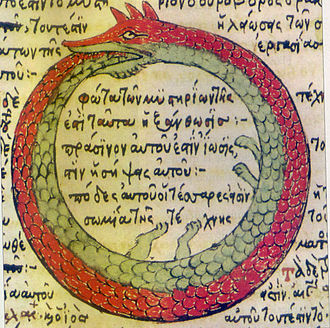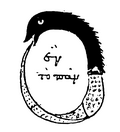Ouroboros


The ouroboros or oroboros is an ancient symbol of a serpent or dragon eating its own tail. The ouroboros is a symbol of an everlasting cycle or a cycle of life, death, and rebirth.
The ouroboros symbolizes eternity or cyclicality.[1] It is the sense of something constantly re-creating itself. Like the phoenix, it symbolises cycles that begin again as soon as they end.
The first known appearance of the ouroboros motif is in KV62, the tomb of Tutankhamun, in the 14th century BC. The text is about the god Ra and his union with Osiris in the underworld. In an illustration, two serpents, with their tails in their mouths, coil around the head and feet of an enormous god (this the unified Ra-Osiris). The whole figure represents the beginning and the end of time.[2]
Ouroboros Media
First known representation of the ouroboros, on one of the shrines enclosing the sarcophagus of Tutankhamun
Early alchemical ouroboros illustration with the words ἓν τὸ πᾶν ("The All is One") from the work of Cleopatra the Alchemist in MS Marciana gr. Z. 299. (10th century)
The ouroboros, Kekulé's inspiration for the structure of benzene
A highly stylised ouroboros from The Book of Kells, an illuminated Gospel Book (c. 800 CE)
References
- ↑ Soto-Andrade, Jorge; Jaramillo, Sebastian; Gutierrez, Claudio; Letelier, Juan-Carlos. "Ouroboros avatars: A mathematical exploration of self-reference and metabolic closure" (PDF). MIT Press. Archived from the original (PDF) on 30 August 2017. Retrieved 16 May 2015.
- ↑ Hornung, Erik 1999. The Ancient Egyptian books of the afterlife. Cornell University Press, 38; 77–78.






